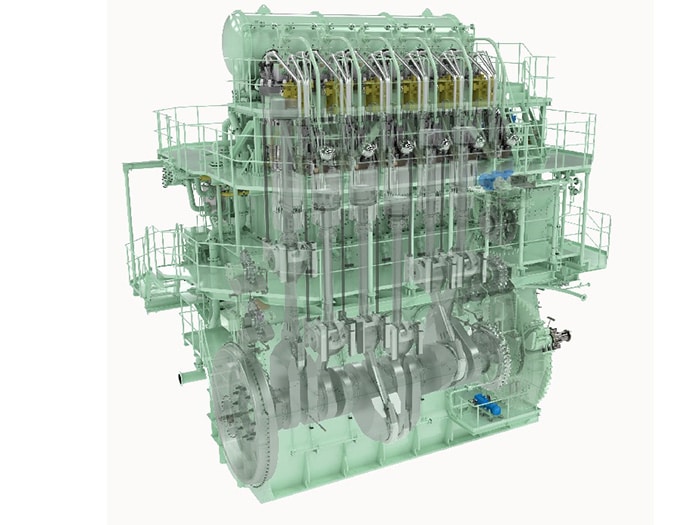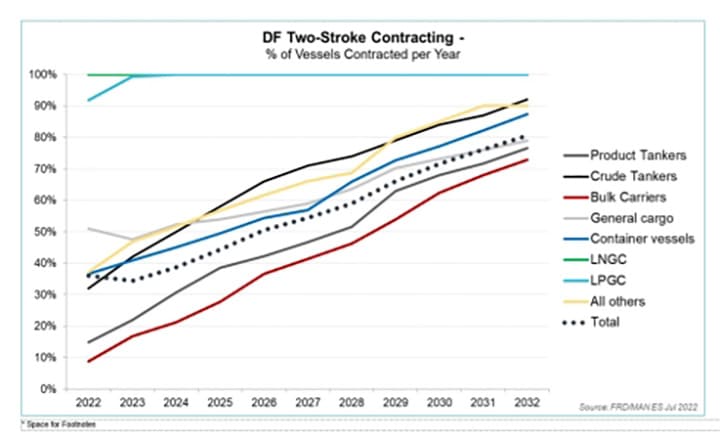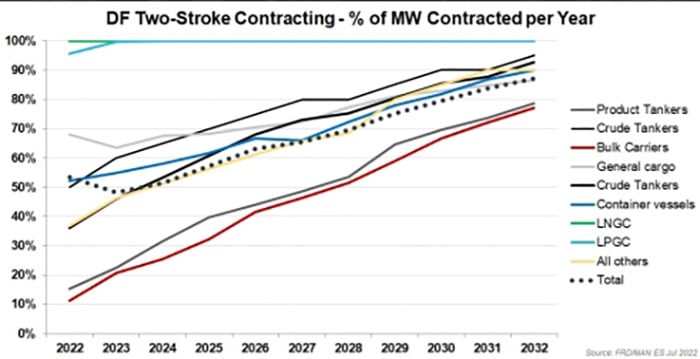
MAN dual fuel two-stroke orders top 1,000 mark
Written by Nick Blenkey
MAN B&W S60ME-GI dual fuel
Nothing is a better indicator of what fuel choices shipowners are making than engine orders and MAN Energy Solutions reports that more than 1,000 of its two-stroke, dual-fuel engines are now on order or in service. These engines can run on a variety of alternative fuels, including LNG, methanol, ethane and LPG. The dual fuel engines’ success accounts for a significant part of an even larger sales milestone of more than 2,500 Tier-III compliant engine orders.


“This is yet another, significant milestone for our dual-fuel portfolio that provides the green solutions desired by the marine market,” said Bjarne Foldager, Senior Vice President and Head of Low-Speed, MAN Energy Solutions. “Our low-speed engines offer multiple paths to decarbonization and we see the increasing adoption of dual-fuel technology as an irreversible trend.”
MAN Energy Solutions’ dual-fuel journey began in 2011 with a full-scale demonstration of an ME-GI (-Gas Injection) engine at its Research Center Copenhagen, followed by delivery of the first engine in 2014.
The ME-GI remains the most successful dual-fuel two stroke with more than 500 orders. MAN says it is the world’s most efficient LNG-fueled engine and has extremely low levels of methane slip, which make it the industry’s leading dual-fuel engine across vessel types such as container vessels, bulk carriers, tankers and car carriers.
The first engine tests of the ME-LGI (-Liquid Gas Injection) platform began in 2015, followed by the first sea-trial for the ME-LGIM (methanol) engine in 2016. Development of an ethane (ME-GIE) unit followed in 2016 with sea-trials already in 2017. Currently, more than 240 dual-fuel engines have entered service, while an MAN B&W ammonia-fueled engine is due to be delivered to a shipyard by 2024.
“Of the thousand dual-fuel engines on order or in service, more than 214 are ME-GA engines, testimony to the success of the second-generation Otto-cycle engine for LNG carriers that offers reduced methane-slip emissions,” says Thomas S. Hansen, Head of Promotion and Customer Support, MAN Energy Solutions. “The first ME-GAs have already been delivered to shipyards and the first vessels will enter service in June 2023. In general, our future outlook on dual-fuel contracting per number of vessels is that 50% of all vessels will be dual-fuel by 2026. Measured in engine power, more than 60% of all ordered engines are expected to be dual-fuel in 2026.”
“The performance of newly developed engines demands heightened attention on their market introduction to optimize performance and resolve any technical challenges,” said Peter Quaade, Head of Dual-Fuel Engine Group – Two-Stroke Operations – MAN Energy Solutions. “Over time, we have identified and resolved issues so that our dual-fuel portfolio is reliable, mature technology that has achieved exceptionally high running-times of more than 95% on alternative fuelshese dual-fuel engines’ seamless switching between fuels, elimination of fuel-slip, and use of the diesel combustion principle ensures that they easily adapt to whatever fuels the industry may prefer in the future.”
Low-Speed, Dual-Fuel MAN B&W Engine Orders
ME-GI 538
ME-GIE 37
ME-LGIM 72
ME-LGIP 139
ME-GA 214




